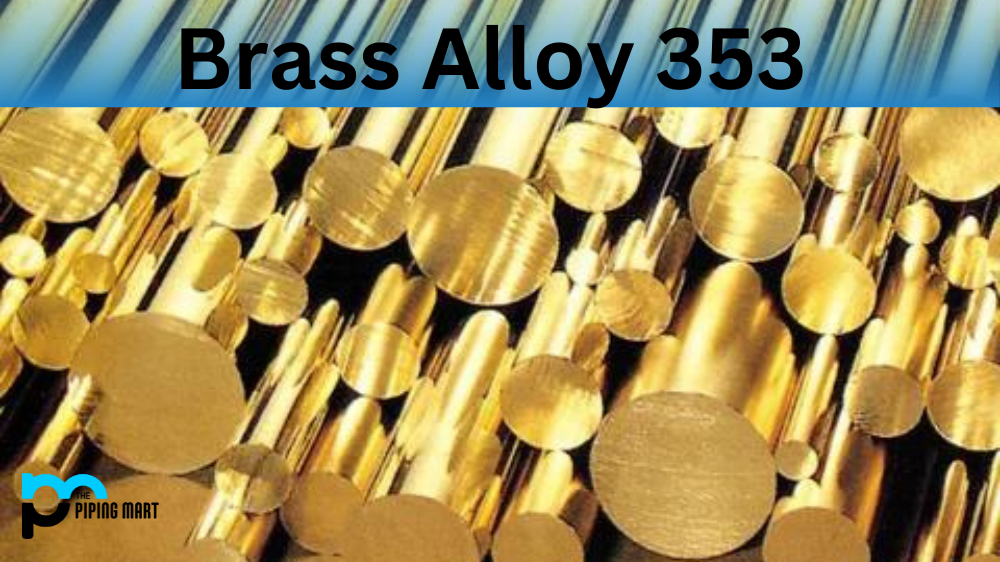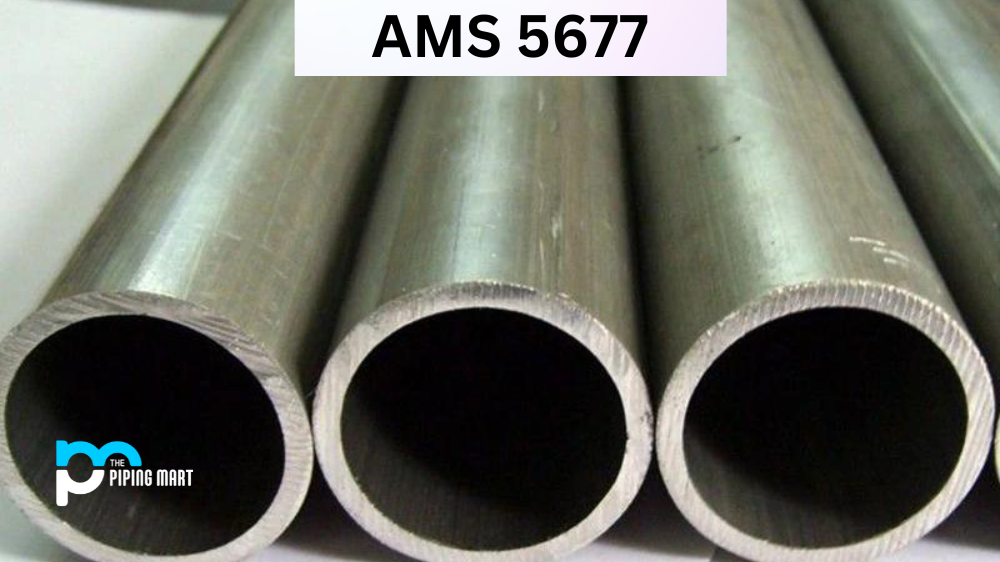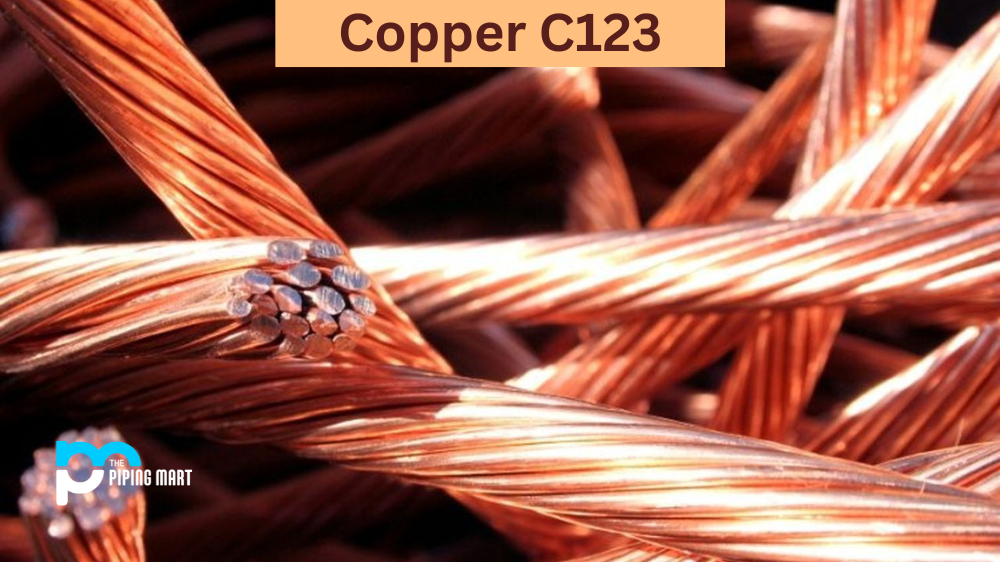UNS C35300 is a unique type of brass with excellent machinability and resistance to corrosion, heat treatment, and heat. It has many uses in the manufacturing industry due to its high mechanical strength, chemical composition, physical properties, and other qualities. Let’s explore what makes brass alloy 353 so special.
353 Brass Alloy Chemical Composition
UNS C35300 is composed of 68.5-71% copper and 29.5-32% zinc. The addition of small amounts of lead (0.02-0.35%) improves machinability while also reducing wear on cutting tools during fabrication processes. In addition to these elements, impurities such as tin, iron, arsenic, aluminum, antimony, bismuth, nickel, and silver may be found in trace amounts in some alloys.
|
Chemistry Information
|
|
|
Element
|
Percentage
|
| Zn | 33.9 – 38.5 |
| Pb | 1.5 – 2.5 |
| Residual | 0 – 0.5 |
| Fe | 0 – 0.1 |
| Cu | 60 – 63 |
353 Brass Alloy Chemical Properties
UNS C35300, composed of copper and zinc, is a strong, durable alloy that offers superior malleability. This alloy has excellent stability in both low and high temperatures, which makes it an ideal choice for applications from engine components to plumbing fittings. Not only does Brass 353 show corrosion resistance in both hot and cold environments, but it also exhibits ductility when put under pressure. This unique combination of characteristics lends it well to highly specialized applications such as heat exchanger components, fuel tanks, and electrical connectors. It goes without saying that Brass 353 is one of the best materials available when performance is required in severe conditions.
353 Brass Alloy Physical Properties
Despite being a lead-free alloy, brass 353 boasts a variety of features that make it an ideal choice for diverse applications. Not only does it exhibit excellent corrosion resistance and good machinability, but it also has impressive tensile strength and hot workability. It is able to withstand temperatures up to 500°F (260°C) with minimal deformation, allowing it to be used in high temperatures without losing its malleable properties. Additionally, this alloy offers pleasing aesthetics that give any finished product a professional look that can’t be matched by other materials. All these qualities put together are why brass 353 is one of the most versatile alloys in the market today.
|
Physical Properties 353
|
|||||
|
-H02
|
|||||
|---|---|---|---|---|---|
| Density | 0.307 lb/in3 | ||||
| Ultimate Tensile Strength | 62 ksi | ||||
| Yield Tensile Strength | 26 ksi | ||||
| Shear Strength | 37 ksi | ||||
| Shear Modulus | 5,660 ksi | ||||
| Hardness Rockwell | Brinell | B66 | 111 | ||||
| Elongation at Break Percentage | 12% | ||||
| Modulus of Elasticity | 15,200 ksi | ||||
| Poisson’s Ratio | 0.31 | ||||
| Machinability Percentage | 90-100% | ||||
| Melting Point | 1,630-1,670 °F | ||||
| Specific Heat | 9.08 x 10^-2 BTU/lb-°F | ||||
| Thermal Conductivity | 798 BTU-in/hr-ft^2-°F | ||||
| Electrical Conductivity | 26% IACS | ||||
353 Brass Alloy Mechanical Properties
UNS C35300 has excellent mechanical properties, including tensile strength ranging from 400-600 MPa depending on tempering temperature and hardness ranging from 110-130 HB depending on tempering temperature as well. This makes it a great choice for applications where strength is required, such as gears, shafts, valves, and fittings. Still, it also provides enough flexibility for low-stress applications such as fasteners or electrical components.
| Properties | Metric | Imperial |
|---|---|---|
| Tensile strength | 338-586 MPa | 49000-85000 psi |
| Yield strength (depending on temper) | 117-427 MPa | 17000-61900 psi |
| Elongation at break ( in 127 mm) | 52% | 52% |
| Modulus of elasticity | 117 GPa | 17000 ksi |
| Poisson’s ratio | 0.34 | 0.34 |
| Machinability (UNS C36000 (free-cutting brass) = 100) | 90 | 90 |
| Shear modulus | 39 GPa | 5660 ksi |
353 Brass Alloy Thermal Properties
| Properties | Metric | Imperial |
|---|---|---|
| Thermal expansion co-efficient (@ 20-300°C/68-572°F ) | 20.3 µm/m°C | 11.3 µin/in°F |
| Thermal conductivity (@ 20°C/68°F) | 115 W/mK | 798 BTU in/hr.ft².°F |
353 Brass Alloy Equivalent Material
Other designations that are equivalent to UNS C35300 brass alloys include:
- ASTM B121
- ASTM B453
353 Brass Alloy Uses
Brass 353 has a variety of uses due to its low lead and corrosion-resistant qualities. Industries such as plumbing and hardware, where it is used as a valve stem material, construction, because of its resistance to forming and machining, and heavy equipment manufacturing, take advantage of its properties. It is also useful in specialized electrical contractors due to its stable arc characteristics. Even the jewelry industry takes advantage of Brass 353 for its low lead content, making it perfect for the production of earrings, pins, bracelets, and other types of jewelry. With so many applications, it’s easy to see why Brass 353 is so popular with manufacturers all over the world.
- Brass is an alloy of copper and zinc.
- Brass has a high resistance to corrosion.
- Brass is often used in plumbing applications.
- Brass can be used to make musical instruments.
- Brass is used in the manufacture of ammunition.
- Brass is used in the construction industry.
- Brass is used in the electrical industry.
- Brass is used in the automotive industry.
- Brass is used in the jewelry industry.
- Brass is used in the manufacturing of coins
Welding
Due to its high zinc content (29%-32%), brass alloy 353 can be welded using any standard welding process, including gas tungsten arc welding (GTAW), shield metal arc welding (SMAW), submerged arc welding (SAW), or gas metal arc welding (GMAW). It is important to note that precautions must be taken when welding this material as zinc fumes are released during the process, which can be hazardous if inhaled for long periods of time or ingested through skin contact with the fumes or fumes that have settled on surfaces near the area where it was being welded.
Corrosion Resistance
Brass 353 is a copper alloy that has superior corrosion resistance when compared to other copper alloys. Its composition of Copper and Zinc prevents it from experiencing oxidation and tarnish, making it an ideal choice for applications where corrosion resistance is essential. The hardness of Brass 353 makes it suitable for use in pumps, valves, marine hardware, and electrical components due to its ability to withstand high temperatures and pressure. Additionally, its smooth surface finish allows for ease of machining and welding, which further helps make Brass 353 an attractive choice among manufacturers.
Heat Resistance
Brass 353 is a great choice for high-temperature applications. It boasts excellent heat resistance and is commonly used in environments that put extreme pressure on components. This makes it an ideal material for aircraft engines, boilers, and high-load pumps, as well as radiators, fans, and hardware that must endure severe operating temperature extremes. In addition to its impressive heat resistance, Brass 353 also has corrosion resistance with qualities similar to stainless steel – making it a long-lasting choice in harsh environmental conditions.
Heat Treatment
Brass 353 is a type of copper and zinc alloy that has optimal properties for making automobile parts, firearms components, and architectural fixtures. Heat treatment of Brass 353 is critical for improving its mechanical characteristics, such as strength, ductility, malleability, and tensile strength. Through the heat treatment process, the internal structure of Brass 353 changes to increase the alloy’s performance within various types of applications. In general, higher temperature heat treatments result in slightly greater material strength, while lower temperatures focus on producing greater ductility or toughness in Brass 353 components. The right combination of heating time and temperature can optimize the mechanical properties of Brass 353 parts to produce a component that meets exacting standards of quality when used in any number of industrial applications.
Machining
The machining of Brass 353 is a delicate process requiring special attention. It requires great skill to create intricate and precise shapes for components used in many industries, from food processing to engineering. Precision drilling, cutting, and grinding ensure that parts are produced with exact measurements and tolerances to meet specific manufacturing needs. With the proper method and tooling, Brass 353 can be crafted into a wide variety of shapes with varying levels of complexity. As such, it has become an essential component for many industries around the world that rely on its excellent strength and malleability for their products.
Conclusion
In conclusion, brass alloy 353 is an excellent choice for many applications due to its excellent machinability, corrosion resistance, heat resistance, and heat treatment capabilities, along with its superior mechanical properties and chemical composition, making it a versatile material for many industries, including automotive manufacturing and industrial machinery production among others. With proper care during installation and maintenance, it can provide years of reliable service in even harsh conditions making it a great choice for any application requiring durability and reliability in extreme temperatures or environments where other materials may fail prematurely. If you’re looking for a reliable material that will stand up to your toughest needs without sacrificing performance, then consider brass alloy 253 – you won’t be disappointed!

Abhishek is a seasoned blogger and industry expert, sharing his insights and knowledge on various topics. With his research, Abhishek offers valuable insights and tips for professionals and enthusiasts. Follow him for expert advice on the latest trends and developments in the metal industry.




